Summary: We will be distinguish the 1080p and 1080i in this article in the aspect of resolution, frames, fields, frequencies. And then give the solution on how to edit both 1080p and 1080i video in FCP X/7/6.Q: I have seen many times resolution of 1080p and I know that mean 1080 pixels but sometime I also seen option on the HDTV is 1080i. So I want to know the exact difference between them and is 1080i video quality available for the laptop too?
I have Googled 1080i some times rather than 1080p. Is there any difference between them? Or they represent the same?The question is specifically: What is the difference between 1080p and 1080i? so I will start by outlining the main similarities and differences, I’ll add some tips on how to choose the best format and then I will proceed to explain the problems that I found here.ResolutionBoth 1080p and 1080i have 1080 horizontal lines of vertical resolution which with a widescreen aspect ratio of 16:9 results in a resolution of 1920 × 1080 pixels (2.1 megapixels). It is not true that 1080i has a lower vertical resolution than 1080p.Frames vs. Fields1080p is a frame-based or progressive-scan video where you are dealing with frames. You have frame rate and it is expressed in frames per second.1080i is a field-based or interlaced or interleaved video where you are dealing with fields. You have field rate and it is expressed in fields per second.A field contains half of the lines of the frame, either even lines or odd lines, and if one field is composed of even lines, then the next one will be composed of odd lines and so on.Frequencies1080p has a frame rate of 25 frames per second for TV in PAL countries, 30/1.001 frames per second for TV in NTSC countries and 24 frames per second for cinematography.1080i has a field rate of 50 fields per second for TV in PAL countries and 60/1.001 fields per second in NTSC countries.How to edit both 1080p and 1080i video in FCP X/7/6 smoothly?For whatever video resolution, frames, fields, frequencies, we got the ultimate usage is make it more vivid or more moving for playback. We always want to add some video effects in the video, though FCP, Avid, Premiere or other NLEs you familiar with. Any editor have it’s natively format for editing, such as Apple Prores for FCP, MEEG-2 for Premiere, DNxHD for Avid. Here we choose FCP as example. Hot Search: XAVC S to Avid | QuickTime Files to Avid | Avid DNxHD MXF to FCP XIn order to edit 1080p and 1080i video in Fcp smoothly. First you should check out the format your 1080p or 1080i video is. In generally speaking the video may not codec in Apple Prores, you should convert the video format into Apple ProRes for FCP. Second, the video resolution, frames, fields, frequencies of 1080i are not suitable for editing in FCP. You’d better change it into 1080p and make it editable. Here we recommend you a professional video tool for you--Pavtube HD Video Converter for Mac(read the review). With it you can change the 1080p or 1080i video into Apple ProRes codec and make it can be edited in FCP smoothly. What's more, the program also boasts with some beneficial functions to enhance you video viewing experience on portable devices. For example, you can trim the video to cut unwanted clips from the video, adjust the output video aspect ratio to make it suitable for your output device, add external subtitles to YouTube movies to understand it better. 
 Other Download:
Step 1: Import 1080p or 1080i video to the program.Click "Files" menu, from its drop-down option, select "Add Video/Audio" to load source 1080p or 1080i videos to the program.
Other Download:
Step 1: Import 1080p or 1080i video to the program.Click "Files" menu, from its drop-down option, select "Add Video/Audio" to load source 1080p or 1080i videos to the program.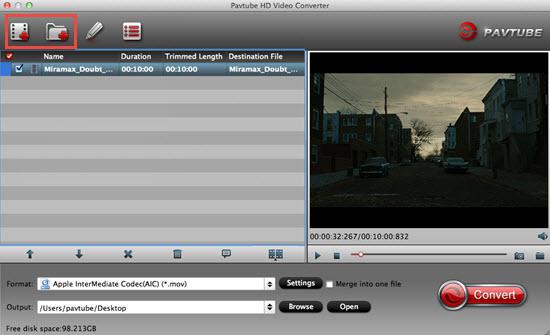 Step 2: Choose output format.Click "Format" bar, from its drop-down options, move your mouse to "Final Cut Pro > Apple ProRes 422 (*.mov)" to select it as the output file format.
Step 2: Choose output format.Click "Format" bar, from its drop-down options, move your mouse to "Final Cut Pro > Apple ProRes 422 (*.mov)" to select it as the output file format.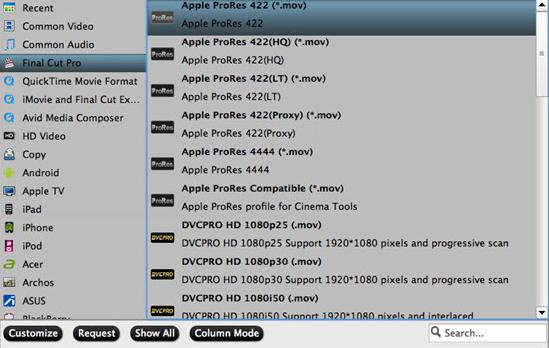 Step 3: Customize output ProRes parameters.Open "Profile Settings" window to adjust the output video codec, size, bit rate, frame rate, audio codec, sample rate, bit rate and channels.
Step 3: Customize output ProRes parameters.Open "Profile Settings" window to adjust the output video codec, size, bit rate, frame rate, audio codec, sample rate, bit rate and channels.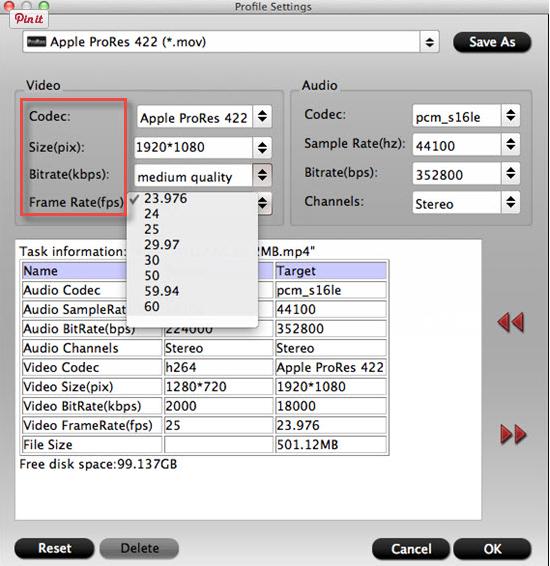 Step 4: Convert 1080p or 1080i video to FCP X/7/6.Hit the convert button under the preview windows, the program will start 1080p or 1080i video to Apple ProRes MOV conversion for Final Cut Pro X/7/6.When the conversion is completed, run FCP and import the ProRes codec footage for post production workflow.Read More:
Step 4: Convert 1080p or 1080i video to FCP X/7/6.Hit the convert button under the preview windows, the program will start 1080p or 1080i video to Apple ProRes MOV conversion for Final Cut Pro X/7/6.When the conversion is completed, run FCP and import the ProRes codec footage for post production workflow.Read More:
Summary: Can Final Cut Pro X/7/6 edit DJI Phantom 4K mp4 files? Why my Final Cut Pro X/7/6 won’t play DJI Phantom 4k MOV files ? What should I do in order to open and play DJI 4k mov files in Final Cut Pro X/7/6? In this article, we will teach you how to convert DJI Phantom 3 4K MOV footage to Final Cut Pro X/7/6 for smooth editing.The DJI Phantom 3 is a well-built, ready-to-fly quadcopter that captures excellent 4K-resolution video. you're shooting 4K videos and capturing 12 megapixel photos that look crisper and cleaner. However, things would be a little more complicated when you work with the DJI Phantom 3 4K in Final Cut Pro X/7/6. Final Cut Pro X/7/6 does not recognize MOV files from DJI Phantom. The file type is a compressed output format; not ideal for editing in NLE system. Something else, Final Cut Pro X/7/6 lacks support for 4K video. To solve those problems, the quick workaround is to transcode Phantom 3 4K MOV files to Final Cut Pro X/7/6 natively supported formats (Apple PreRes 422 *.mov are highly recommended) in proper settings.That's where Pavtube Video Converter comes in: It supports converting DJI Inspire 3 4k MOV files to Final Cut Pro X/7/6 highly compatible Apple PreRes 422 *.mov without quality loss. Besides, it also supports the decent outputs for Avid MC, Adobe Premier Pro, Sony Vegas, Pinnacle Studio and more to meet different of needs. Just download it and follow the step-by-step guide to transcode DJI Inspire 4k MOV files for editing in Window Movie Maker smoothly.
Final Cut Pro X/7/6 does not recognize MOV files from DJI Phantom. The file type is a compressed output format; not ideal for editing in NLE system. Something else, Final Cut Pro X/7/6 lacks support for 4K video. To solve those problems, the quick workaround is to transcode Phantom 3 4K MOV files to Final Cut Pro X/7/6 natively supported formats (Apple PreRes 422 *.mov are highly recommended) in proper settings.That's where Pavtube Video Converter comes in: It supports converting DJI Inspire 3 4k MOV files to Final Cut Pro X/7/6 highly compatible Apple PreRes 422 *.mov without quality loss. Besides, it also supports the decent outputs for Avid MC, Adobe Premier Pro, Sony Vegas, Pinnacle Studio and more to meet different of needs. Just download it and follow the step-by-step guide to transcode DJI Inspire 4k MOV files for editing in Window Movie Maker smoothly.
 Other Download:- Pavtube old official address: http://www.pavtube.com/video_converter/- Amazon Download: http://download.cnet.com/Pavtube-Video-Converter/3000-2194_4-75734821.html- Cnet Download: http://download.cnet.com/Pavtube-Video-Converter/3000-2194_4-75734821.htmlSimple Guide : Convert and Import DJI Phantom 3 4K to FCP X/7/XStep 1. Install the Mac 4K Converter program and run it. Drag the 4K .mov files to the software. Or you can also click "Add" button on the top of the main interface to import video to the program.
Other Download:- Pavtube old official address: http://www.pavtube.com/video_converter/- Amazon Download: http://download.cnet.com/Pavtube-Video-Converter/3000-2194_4-75734821.html- Cnet Download: http://download.cnet.com/Pavtube-Video-Converter/3000-2194_4-75734821.htmlSimple Guide : Convert and Import DJI Phantom 3 4K to FCP X/7/XStep 1. Install the Mac 4K Converter program and run it. Drag the 4K .mov files to the software. Or you can also click "Add" button on the top of the main interface to import video to the program.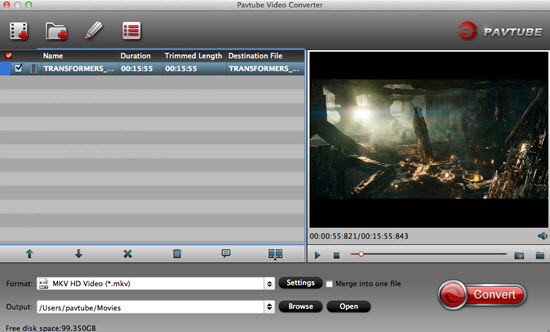 Step 2. Choose ProRes as output formatClick the "Format" bar and select Final Cut Pro> Apple PreRes 422(*.mov) as output format.
Step 2. Choose ProRes as output formatClick the "Format" bar and select Final Cut Pro> Apple PreRes 422(*.mov) as output format. 3. Adjust video, audio settingsClick the "Settings" button and customize proper video/audio parameters including Video size, bitrate and fame rate and mroe. Usually 1920*1080 video size and 30fps video frame rate are recommended for FCP editing. Well, if you prefer to work with 4K video, you can adjust video size to get 4K ProRes for FCP.
3. Adjust video, audio settingsClick the "Settings" button and customize proper video/audio parameters including Video size, bitrate and fame rate and mroe. Usually 1920*1080 video size and 30fps video frame rate are recommended for FCP editing. Well, if you prefer to work with 4K video, you can adjust video size to get 4K ProRes for FCP.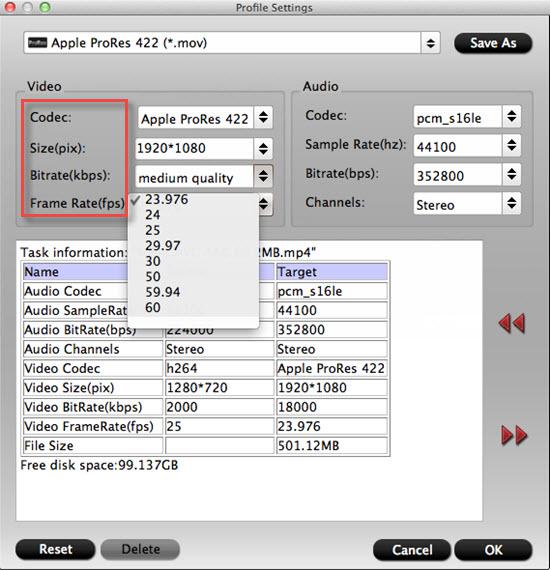 4. Start conversionAfter all necessary settings, hit the convert button to start the DJI Phantom 3 4K video to ProRes conversion on Mac OS X. Once the conversion process shows in 100%, click Open to get the output videos. Create a project and start editing DJI Phantom 3 4K MP4/MOV videos in FCP 6/7/X with light speed.When the conversion is completed, launch FCP X/6/7, go to "File" > "Import" > "Media" to add the converted prores files to FCP X/6/7 for further professional editing. You do not need to check "Create Optimized Media" or "Create Proxy Media" option since we already converted the media to ProRes which means Final Cut Pro X can use the footage without "optimizing" it. Checking this box would create a redundant and time consuming second transcode of your footage.Recommended Devices for control via the app.iOS: iPhone 5s, iPhone 6, iPhone 6 Plus, iPad Air, iPad Air Wi-Fi + Cellular, iPad mini 2, iPad mini 2 Wi-Fi + Cellular, iPad Air 2, iPad Air 2 Wi-Fi + Cellular, iPad mini 3, and iPad mini 3 Wi-Fi + Cellular. This app is optimized for iPhone 5s, iPhone 6, and iPhone 6 PlusAndroid: Samsung S5, Note 3, Sony Xperia Z3, Google Nexus 7 II, Google Nexus 9, Mi 3, Nubia Z7 mini.Read More:
4. Start conversionAfter all necessary settings, hit the convert button to start the DJI Phantom 3 4K video to ProRes conversion on Mac OS X. Once the conversion process shows in 100%, click Open to get the output videos. Create a project and start editing DJI Phantom 3 4K MP4/MOV videos in FCP 6/7/X with light speed.When the conversion is completed, launch FCP X/6/7, go to "File" > "Import" > "Media" to add the converted prores files to FCP X/6/7 for further professional editing. You do not need to check "Create Optimized Media" or "Create Proxy Media" option since we already converted the media to ProRes which means Final Cut Pro X can use the footage without "optimizing" it. Checking this box would create a redundant and time consuming second transcode of your footage.Recommended Devices for control via the app.iOS: iPhone 5s, iPhone 6, iPhone 6 Plus, iPad Air, iPad Air Wi-Fi + Cellular, iPad mini 2, iPad mini 2 Wi-Fi + Cellular, iPad Air 2, iPad Air 2 Wi-Fi + Cellular, iPad mini 3, and iPad mini 3 Wi-Fi + Cellular. This app is optimized for iPhone 5s, iPhone 6, and iPhone 6 PlusAndroid: Samsung S5, Note 3, Sony Xperia Z3, Google Nexus 7 II, Google Nexus 9, Mi 3, Nubia Z7 mini.Read More:
Summary: In this article I will show you the best way to fix the general error in final cut pro 7 when you import some Canon video clip for editing. If you in the same trouble, just follow the article and you will fix the problem in short time.Q:Everytime I try to work with .mov files from my Canon, final cut pro gives me a general error after I've added a couple of clips to the timeline, it used to be no problem but I don't know how to solve the general error... any help?I once edited a whole project in FCP 7 using the native Canon 5D files and while it started well enough, it got more instable as the timeline filled and renders got glitches between edits.Using files straight from camera is ideal and works very well with Adobe Premiere or Final Cut X, and I highly recommend switching to one of those. You have to know FCP 7 is 32 bits, doesn't support more than one CPU, and is no longer supported by Apple. Chances are, the latest version of FCP 7 is older than your camera and it will stay that way forever. And unless you are using a computer from 6 years ago, you are also waiting way longer than you have to for your renders.If you absolutely want to keep using FCP 7, you are going to have to convert your footage to good old proRes beforehand. You can use FCP's media manager or Apple Compressor for that. Alternatively, do yourself a favour and get a modern NLE like FCPX which handles and optimises files from almost all cameras automatically. As FCP 7 are not workable with Canon files natively, if you want to load Canon files to FCP (including FCP 7 and FCP X), first you need to convert Canon files to FCP 7 friendly codec like Apple Prores. of course, losslessly. To do so, you need a professional Video Converter to help.Hot Search: H.264 MP4 Footage into Final Cut Pro | AVCHD M2TS to FCP | XC 10 4K/1080p MXF to Premiere ProHere I'd like to recommend an excellent HD Video Converter for Mac from Pavtube. It can convert ALL(Canon videos included) videos to Apple ProRes codec which is intermediate format that features high performance and quality, being less processor-intensive to work with FCP 7.
 Other Download:- Pavtube old official address: http://www.pavtube.com/hd-video-converter-mac/- Amazon Store Download: http://www.amazon.com/Pavtube-Video-Converter-Mac-Download/dp/B00QI9GNZS- AppStore Download: https://itunes.apple.com/de/app/pavtube-hd-video-converter/id502792488?mt=12- Cnet Download: http://download.cnet.com/Pavtube-HD-Video-Converter/3000-2194_4-76177786.htmlHow to load All(Canon) videos to FCP 7?Step 1: click top left icons to load your sources. You can load individual videos from by clicking "add videos", or load the entire folder by clicking ‘add from folder'.
Other Download:- Pavtube old official address: http://www.pavtube.com/hd-video-converter-mac/- Amazon Store Download: http://www.amazon.com/Pavtube-Video-Converter-Mac-Download/dp/B00QI9GNZS- AppStore Download: https://itunes.apple.com/de/app/pavtube-hd-video-converter/id502792488?mt=12- Cnet Download: http://download.cnet.com/Pavtube-HD-Video-Converter/3000-2194_4-76177786.htmlHow to load All(Canon) videos to FCP 7?Step 1: click top left icons to load your sources. You can load individual videos from by clicking "add videos", or load the entire folder by clicking ‘add from folder'. Step 2: Choose Apple ProRes 422 codec for Final Cut Pro 7.Click the "Profile" option, and move mouse cursor to Final Cut Pro > Apple ProRes 422 HQ (*.mov) as output format.
Step 2: Choose Apple ProRes 422 codec for Final Cut Pro 7.Click the "Profile" option, and move mouse cursor to Final Cut Pro > Apple ProRes 422 HQ (*.mov) as output format. Tips:To keep original video quality for editing in FCP, select “Apple ProRes 422”;For SD levels – 480i/p and 576i/p and offline workflows, select “Apple ProRes 422 (Proxy)”;To edit and finish 4:4:4 material, choose “Apple ProRes 4444″.Learn more Apple ProRes, please refer to Types of Apple ProRes CodecsTo get 1080 videos, we need to click the "Settings" button and choose 1920*1080 as output video resolution.Step 3: Convert all video files for FCP 7.Click the read button Convert to start transcoding alll video files to MOV for FCP 7. When the conversion is completed, click "Open" button to locate the converted Apple ProRes 422 MOV files for editing with Final Cut Pro 7.Pavtube Video Converter for Mac: An all-in-one program integrating conversion and editing 4K videos, 1080p/720p MKV, MXF, M2TS, etc. on Mac OS X El Capitan.Pavtube iMedia Converter for Mac: An all-inclusive converter to complete 2D/3D Blu-ray, DVD, ISO, SD/HD/4K Video to m3u8, H.265 MP4, do H.265 to non-H.265 conversion on Mac OS X El Capitan.MP4 to FCP
Tips:To keep original video quality for editing in FCP, select “Apple ProRes 422”;For SD levels – 480i/p and 576i/p and offline workflows, select “Apple ProRes 422 (Proxy)”;To edit and finish 4:4:4 material, choose “Apple ProRes 4444″.Learn more Apple ProRes, please refer to Types of Apple ProRes CodecsTo get 1080 videos, we need to click the "Settings" button and choose 1920*1080 as output video resolution.Step 3: Convert all video files for FCP 7.Click the read button Convert to start transcoding alll video files to MOV for FCP 7. When the conversion is completed, click "Open" button to locate the converted Apple ProRes 422 MOV files for editing with Final Cut Pro 7.Pavtube Video Converter for Mac: An all-in-one program integrating conversion and editing 4K videos, 1080p/720p MKV, MXF, M2TS, etc. on Mac OS X El Capitan.Pavtube iMedia Converter for Mac: An all-inclusive converter to complete 2D/3D Blu-ray, DVD, ISO, SD/HD/4K Video to m3u8, H.265 MP4, do H.265 to non-H.265 conversion on Mac OS X El Capitan.MP4 to FCP ǀ
AVCHD to FCP ǀ
MOV to FCP ǀ
H.265 to FCP
Summary: As for the professional NLEs, a few years ago the answer was simple FCP or Premiere. Over the past 2 years the industry has gone through some major changes. Here we talk about the different between the Final Cut Pro and Adobe Premiere and give the solution of how to import any video into them for editing natively.Apple abandoned FCP7 and launched an all new NLE called FCPX. It was a radical change and it broke many professional post houses workflows. This created a major backlash for Apple. FCPX has improved since launch and some Pros are using it.Adobe Premiere has gained enormous market share from FCP users. Many loyal FCP editors refer to Premiere Pro CS6 as the FCP8 they wanted but did not get. Premiere has become far more professional, stable and powerful over the past couple of years.Since the release of Final Cut Pro X, there have been a number of professional video editors moving to Adobe Premiere Pro and Avid Media Composer, due to Apple's seeming lack of interest in the professional market.I'm not to sure about the recent updates for FCP, but last I heard there were a great many features that were considered necessary tools for professional work that Apple had decided not to include.I've been cutting on Adobe Premiere Pro for years now, and I love everything about it. The Mercury Playback Engine makes rendering simple effects unnecessary, and the integration with the rest of the Adobe Creative Suite is simply phenomenal. Premiere Pro let's you edit most video formats natively (P2, Red, Arri, Canon XF, etc.) without having to transcode into an intermediate codec like Apple ProRes.In the rest of the article we talk about how to import any video into them for editing natively.As we all know that like all the = professional non-linear video editing program, Final Cut Pro and Adobe Premiere different also has its own native editing codec - MPEG-2 for Adobe Premiere and Apple ProRes for Final Cut Pro, which is specially designed for nonlinear editing and complex multi-generation composing in post production. To create Final Cut Pro and Adobe Premiere editing codec, you can download Pavtube HD Video Converter for Mac(read the review), a professional Mac video decoder to beneficially encode all kinds of videos to Final Cut Pro and Adobe Premiere optimized MPEG-2/Apple ProRes codec.Moreover, Pavtube HD Video Converter for Mac also allows you to customize profile settings to get a desired and better output. Movie creation with this program is no big deal. You can edit your video files by trimming, cropping, attaching external subtitles, adding watermarks, change video effect, etcBy the way, if your are a one hundred percent Windows user, please turn to Pavtube HD Video Converter. It has the same ability as Mac version.
 Other Download:
How to Convert any Video to Final Cut Pro and Adobe Premiere for Smoothly EditingStep 1: Input video files.Start the program on your computer, add video to the program by clicking the "Add Video" or "Add folder" button.
Other Download:
How to Convert any Video to Final Cut Pro and Adobe Premiere for Smoothly EditingStep 1: Input video files.Start the program on your computer, add video to the program by clicking the "Add Video" or "Add folder" button.  Step 2: Choose format to output.For FCP users, from "Format" drop-down option, choose "Final Cut Pro"> "Apple Prores 422(*.mov)" as output format. To output higher quality video, it is ideal for you to output "Apple Prores 422(*.mov)" or "Apple Prores 422(HQ)(*.mov)" format. To output small size video, choose Apple Prores 422(LT)(*.mov) or Apple Prores 422(Proxy)(*.mov) format.For Premiere users, click "Format" bar, from its drop-down list, select "Adobe Premiere Pro/Son..." > "MPEG-2 (*.mpg)" to output for editing with Premiere Pro CC.
Step 2: Choose format to output.For FCP users, from "Format" drop-down option, choose "Final Cut Pro"> "Apple Prores 422(*.mov)" as output format. To output higher quality video, it is ideal for you to output "Apple Prores 422(*.mov)" or "Apple Prores 422(HQ)(*.mov)" format. To output small size video, choose Apple Prores 422(LT)(*.mov) or Apple Prores 422(Proxy)(*.mov) format.For Premiere users, click "Format" bar, from its drop-down list, select "Adobe Premiere Pro/Son..." > "MPEG-2 (*.mpg)" to output for editing with Premiere Pro CC.
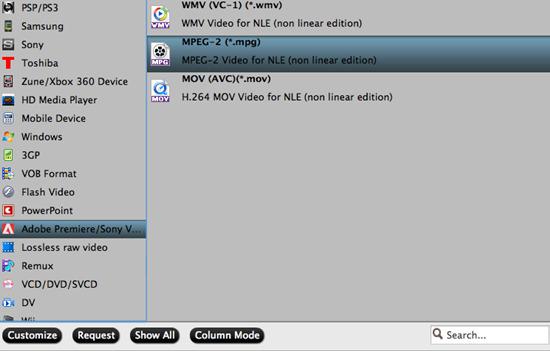 Step 3: Customize output video and audio settings.Open "Profile Settings" window to adjust output video and audio parameter settings according to your own preference.
Step 3: Customize output video and audio settings.Open "Profile Settings" window to adjust output video and audio parameter settings according to your own preference.
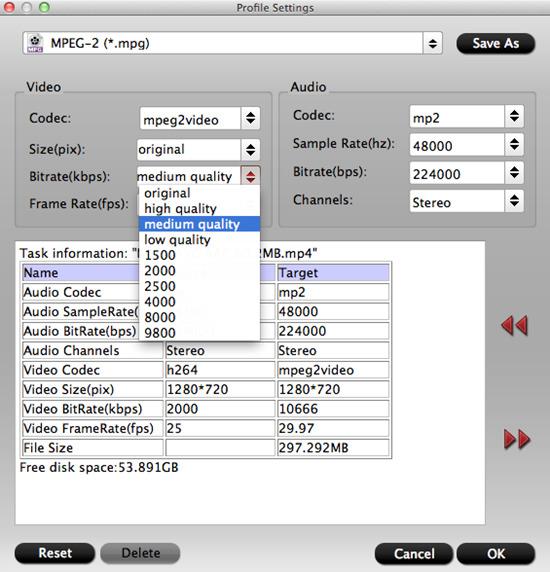 Step 4: Start the conversion process.After all the setting is over, go back to the main interface and hit right-bottom "Convert" button to start the Apple Prores 422 or MPEG-2 conversion process.When the conversion is completed, launch FCP/Premiere and import the converted video to it and then you can be editing the converted video smoothly.Read More:
Step 4: Start the conversion process.After all the setting is over, go back to the main interface and hit right-bottom "Convert" button to start the Apple Prores 422 or MPEG-2 conversion process.When the conversion is completed, launch FCP/Premiere and import the converted video to it and then you can be editing the converted video smoothly.Read More:
Summary: If you have a Roku 4, a Plex, and a 4K OLED TV. You will absolutely want to transfer the 4K video you just recorded on Christmas Party on Roku 4 via Plex.Roku has announced the latest version of their video streaming player. Roku 4 comes with a faster quad core processor, supports 4K UHD HEVC and 4K UHD VP9 video playback up to respectively 2160p60 and 2160p30, and includes a new version of Roku operating systems. Roku 4 has its own limited playable formats,only the Roku 4 supports video files with 4k resolution. They also must either be encoded with VP9 codec or H.265 codec. You can watch them on any TV hooked to the Roku 4. As 4K camcorder records video with 4k MXF , 4K MOV, 4K MP4, or 4K XAVC/XAVC-S,etc. So, we can not import all 4k videos to Roku 4 for playback.From roku.com we get the get the following media file formats are supported:
- Video — H.264/AVC (.MKV, .MP4, .MOV), on Roku 4 only: H.265/HEVC (.MKV, .MP4, .MOV); VP9 (.MKV)
- Audio – AAC (.MKV, .MP4, .MOV); MP3(.MP3, .MKV); WMA (.ASF, .WMA, .MKV), FLAC (.FLAC, .MKV), PCM (.WAV, .MKV, .MP4, .MOV), AC3/EAC3 (.MKV,.MP4. .MOV, .AC3), DTS (.MKV, .MP4, .MOV), ALAC (.MKV, .MP4, .MOV, .M4A)
- Image — JPG, PNG, GIF (non-animated)
Only supported file types are shown in the Roku Media Player channel. The channel hides unsupported file types.Multichannel AAC is not supported on all Roku models. Roku TV’s and Roku 4 set-top-boxes do support multichannel decode to PCM stereo.DTS is only supported via pass through on both Roku set-top-boxes and Roku TV’s. You must connect your Roku player via HDMI or S/PDIF to a TV or receiver capable of decoding Dolby Digital or DTS in order to hear videos with audio tracks in those formats.Some media server software may convert files into Roku compatible formats.DRM-protected content is not supported.Hot Search: Blu-ray to H.265 | Encode Any Videos to H.265 | YouTube Videos on RokuTherefore, if you want to stream some 4K videos such as 4k MXF , 4K MOV, 4K MP4, or 4K XAVC/XAVC-S files to Roku 4 or Apple TV 4 for playback, an 4K to converter is needed. Among many apps on the market, Pavtube HD Video Converter for Mac(read the review) is the top-ranked one. It can transcode any 4K UHD videos to Roku 4 in H.265 MP4, with excellent video quality. In settings window, you can freely adjust the video and audio size, codec, nitrate, frame rate, etc to get more compatible video with Roku 4. If you are a Windows user, please turn to Pavtube HD Video Converter, the same ability as Mac version.
 Other Download:
How to Convert 4K Video to H.265 for Roku 4Step 1. Import 4K video to HD converterDownload and launch this Mac HD video converter, and click “File” and “Add Video/Audio” to add source videos.
Other Download:
How to Convert 4K Video to H.265 for Roku 4Step 1. Import 4K video to HD converterDownload and launch this Mac HD video converter, and click “File” and “Add Video/Audio” to add source videos. Step 2: Select output file format.Click "Format" bar, you can choose "H.265 Video(*.mp4)" as the output format from the format list.
Step 2: Select output file format.Click "Format" bar, you can choose "H.265 Video(*.mp4)" as the output format from the format list.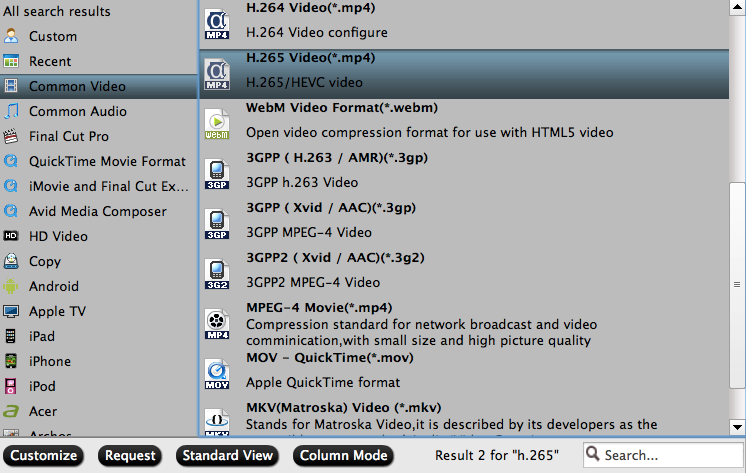 Step 3. Compress 4K videos (Optional)Hit "Settings" on the main interface, you will open the "Parameters" window, here, you can set the output video codec, size, frame rate, bit rate, audio codec, bit rate, sample rate and channels to improve output video quality.Step 4. Convert 4K video to Roku 4 or Apple TV 4Once everything is settled for conversion, click “Convert” on main interface to make your source videos converted. After conversion, you’ll get the expected and desired video format well accepted by Roku 4.Step 5. Import converted videos to Roku 4. You can find the generated files by clicking "Open output folder" when the conversion is completed. Transfer them to an external USB hard drive and plug the drive into your Roku 4, you will have no difficulty to watch 4K videos on your large screen HDTV via Roku 4.Read More:
Step 3. Compress 4K videos (Optional)Hit "Settings" on the main interface, you will open the "Parameters" window, here, you can set the output video codec, size, frame rate, bit rate, audio codec, bit rate, sample rate and channels to improve output video quality.Step 4. Convert 4K video to Roku 4 or Apple TV 4Once everything is settled for conversion, click “Convert” on main interface to make your source videos converted. After conversion, you’ll get the expected and desired video format well accepted by Roku 4.Step 5. Import converted videos to Roku 4. You can find the generated files by clicking "Open output folder" when the conversion is completed. Transfer them to an external USB hard drive and plug the drive into your Roku 4, you will have no difficulty to watch 4K videos on your large screen HDTV via Roku 4.Read More:
Summary: Can Windows Media Player play DJI Phantom 4K mp4 files? Why my Windows Media Player won’t play DJI Phantom 4k MOV files ? What should I do in order to open and play DJI 4k mov files in Windows Media Player? In this article, we will teach you how to convert DJI Phantom 3 4K MOV footage to Windows Movie Maker for smooth editing.The DJI Inspire 3 is a well-built, ready-to-fly quadcopter that captures excellent 4K-resolution video. you're shooting 4K videos and capturing 12 megapixel photos that look crisper and cleaner. However, things would be a little more complicated when you work with the DJI Phantom 3 4K in Windows Movie Maker.Windows Movie Maker does not recognize MOV files from DJI Phantom. The file type is a compressed output format; not ideal for editing in NLE system. Something else, Windows Movie Maker lacks support for 4K video. To solve those problems, the quick workaround is to transcode Phantom 3 4K MOV files to Windows Movie Maker natively supported formats (WMV/AVI are highly recommended) in proper settings.That's where Pavtube Video Converter comes in: It supports converting DJI Inspire 3 4k MOV files to Windows Movie Maker highly compatible WMV or AVI without quality loss. Besides, it also supports the decent outputs for Avid MC, Adobe Premier Pro, Sony Vegas, Pinnacle Studio and more to meet different of needs. Just download it and follow the step-by-step guide to transcode DJI Inspire 4k MOV files for editing in Window Movie Maker smoothly.
 Other Download:- Pavtube old official address: http://www.pavtube.com/video_converter/- Amazon Download: http://download.cnet.com/Pavtube-Video-Converter/3000-2194_4-75734821.html- Cnet Download: http://download.cnet.com/Pavtube-Video-Converter/3000-2194_4-75734821.htmlGuide on Downscaling DJI 4K to 1080p for editingStep 1. Load the 4K files of DJI.Click "Add Video" button to load your DJI Phantom 3 4K files as soon as you get into the main interface. Or you can drag & drop the files to the software directly.
Other Download:- Pavtube old official address: http://www.pavtube.com/video_converter/- Amazon Download: http://download.cnet.com/Pavtube-Video-Converter/3000-2194_4-75734821.html- Cnet Download: http://download.cnet.com/Pavtube-Video-Converter/3000-2194_4-75734821.htmlGuide on Downscaling DJI 4K to 1080p for editingStep 1. Load the 4K files of DJI.Click "Add Video" button to load your DJI Phantom 3 4K files as soon as you get into the main interface. Or you can drag & drop the files to the software directly. Step 2. Choose the output formatClick the "Profile" drop down list to select a proper video foramt as you want. Here you just need to hit the "Profile" box and select "HD Video" > "WMV HD" on the dropdown menu as output format.
Step 2. Choose the output formatClick the "Profile" drop down list to select a proper video foramt as you want. Here you just need to hit the "Profile" box and select "HD Video" > "WMV HD" on the dropdown menu as output format. 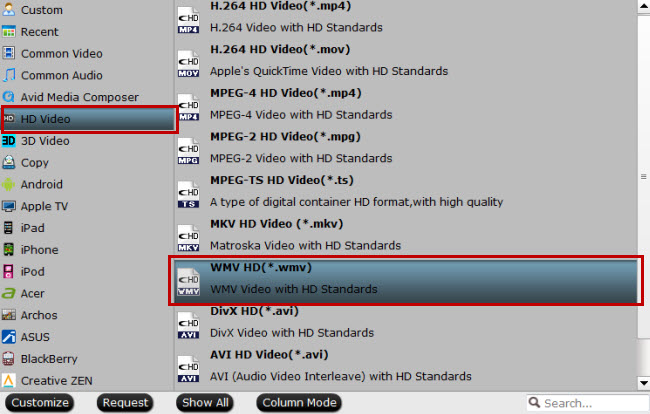 Step 3. Set Video Resolution at 1080p.Click "Settings" button; you can adjust video and audio settings, including codec, aspect ratio, bit rate, frame rate, sample rate, and audio channel. To down-convert ultra HD 4K to 1080p, do remember adjusting video size to 1920*1080. That is the exact 108p.
Step 3. Set Video Resolution at 1080p.Click "Settings" button; you can adjust video and audio settings, including codec, aspect ratio, bit rate, frame rate, sample rate, and audio channel. To down-convert ultra HD 4K to 1080p, do remember adjusting video size to 1920*1080. That is the exact 108p.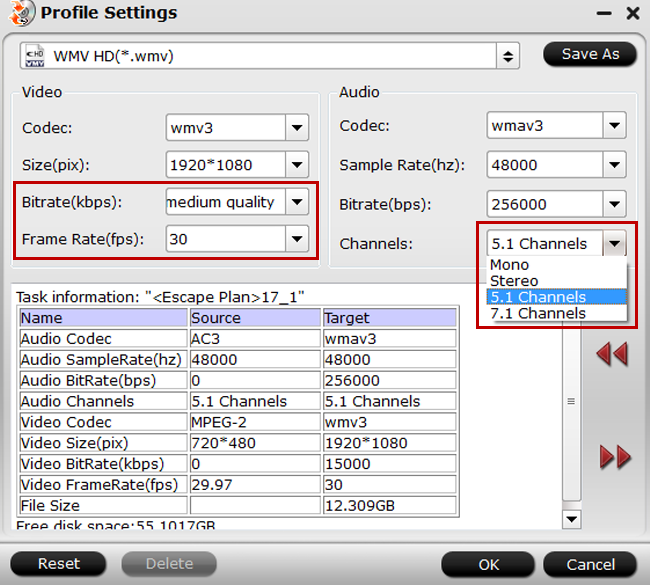 Step 3. Start transcoding DJI 4K to 1080p on MacWhen everything is OK, hit "Convert" button at the bottom of the main interface to let the 4K to 1080p conversion begin.When the conversion finished, check the generated 1080p video, you will certainly be satisfied with its final video quality. It would be easier for you to playback and edit your DJI Phantom 3 4K clips. Enjoy.Read More:
Step 3. Start transcoding DJI 4K to 1080p on MacWhen everything is OK, hit "Convert" button at the bottom of the main interface to let the 4K to 1080p conversion begin.When the conversion finished, check the generated 1080p video, you will certainly be satisfied with its final video quality. It would be easier for you to playback and edit your DJI Phantom 3 4K clips. Enjoy.Read More:
Summary: If you used to edit video in ScreenFlow, and you know litter about other editor, however, you have problem of importing the MOV into ScreenFlow, what should you do? Take it easy, this article will show you the unimport reason and give tutorial to get it work.In my experience with ScreenFlow, if QuickTime can open the movie, ScreenFlow can edit it. If QuickTime can't open the file, you might consider to convert unsupported MOV videos into QuickTime compatible format for importing into ScreenFlow, since the mov video may be codec in other QuickTime incompatible codec.Has mentioned above if you want to play and edit MOV videos on ScreenFlow, just convert MOV to QuickTime MOV. There are many kinds of MOV converter software in the market. The output video quality and the converting speed must be the key factors that you should be looking out for. Pavtube HD Video Converter for Mac(read the review) provides Mac users the easiest and smartest way to convert incompatible MOV to QuickTime MOV on Mac (El Capitan). Equipped with high quality engine and hyper threading technology, even support Multi-core CPU and hardware encoding technology, this HD video converter for Mac can convert incompatible MOV to QuickTime MOV format without suffering any quality loss, up to 5X faster than other converters in the market.
 Other Download:
How to Convert Incompatible MOV to QuickTime Player .MOV for Editing on ScreenFlow?Step 1: Add incompatible MOV files.Launch the program on your computer, add incompatible MOV files to the program by clicking the "Add Video" or "Add folder" button.
Other Download:
How to Convert Incompatible MOV to QuickTime Player .MOV for Editing on ScreenFlow?Step 1: Add incompatible MOV files.Launch the program on your computer, add incompatible MOV files to the program by clicking the "Add Video" or "Add folder" button. Step 2: Choose output file format.From "Format" drop-down option, choose QuickTime natively supported format by following "Common Video" > "MOV - QuickTime (*.mov)".
Step 2: Choose output file format.From "Format" drop-down option, choose QuickTime natively supported format by following "Common Video" > "MOV - QuickTime (*.mov)".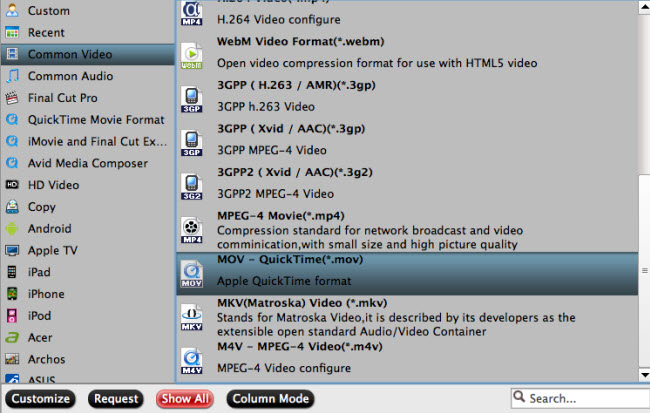 Step 3: Customize output video and audio settings.Open "Profile Settings" window to adjust output video and audio parameter settings such as video codec, size, bit rate, frame rate, audio codec, bit rate, frame rate, channels, etc according to your own preference.Step 4: Start the conversion process.After all the setting is over, go back to the main interface and hit right-bottom "Convert" button to start incompatible MOV video to QuickTime mov conversion process.When the conversion is completed, you will have no limitation to importing converted incompatible MOV video footage on ScreenFlow.Related program: Pavtube Media Magician / Mac Version: A nice camcorder assistant manager, lossless camcorder video joiner, MTS/ M2TS/ MXF/ MOV/ MKV/ TiVo/ WMV/ AVI/ MPG converter and editor. Meamwhile it supported upload edited video to YouTube directly.Read More:
Step 3: Customize output video and audio settings.Open "Profile Settings" window to adjust output video and audio parameter settings such as video codec, size, bit rate, frame rate, audio codec, bit rate, frame rate, channels, etc according to your own preference.Step 4: Start the conversion process.After all the setting is over, go back to the main interface and hit right-bottom "Convert" button to start incompatible MOV video to QuickTime mov conversion process.When the conversion is completed, you will have no limitation to importing converted incompatible MOV video footage on ScreenFlow.Related program: Pavtube Media Magician / Mac Version: A nice camcorder assistant manager, lossless camcorder video joiner, MTS/ M2TS/ MXF/ MOV/ MKV/ TiVo/ WMV/ AVI/ MPG converter and editor. Meamwhile it supported upload edited video to YouTube directly.Read More:




















